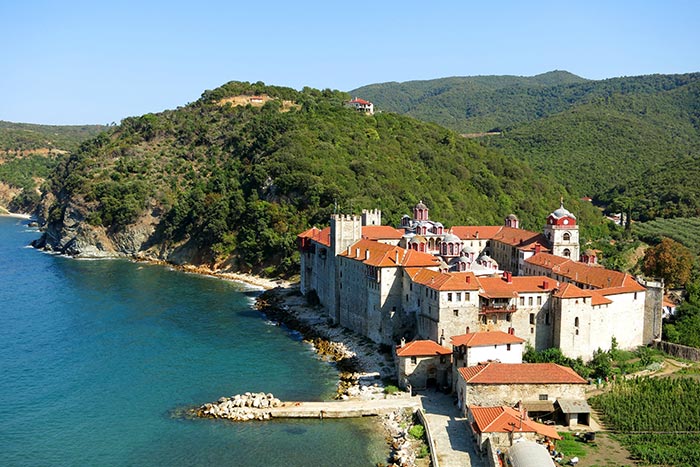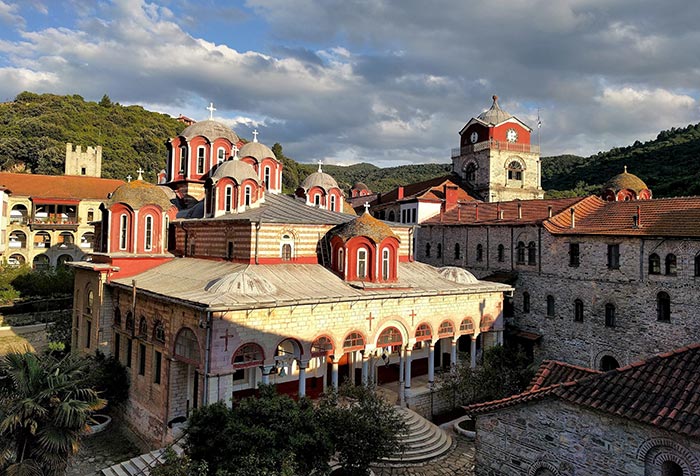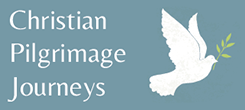
Holy Monastery of Esphigmenou
It is the northernmost of all Athonite monasteries. The current monastery dates back to the 10th century, while tradition holds that the site had been used as a monastery since as early as the 5th century. Esfigmenos ranks eighteenth in the hierarchy of the Athonite monasteries and since the early 1970s has been embroiled in legal and ecclesiastical disputes. This is the largest monastery on Mount Athos, with around a hundred monks.
The monastery's name literally means tightened, and there are conflicting traditions regarding the origin of the name. One attributes it to the fact that the monastery is built on a stretch of land, tightened by three surrounding hills and the sea. Another tradition attributes the name to a monk who either founded or restored the monastery, recounting that he used to wear a tight rope around his waist, so from him the monastery got its name "of the tightened".
The monastery greatly prospered until the Ottoman conquest. Many Byzantine emperors, such as John V Palaiologos, contributed to this prosperity, as did other Orthodox rulers. This prosperity was however shrouded by constant disputes over land issues with the neighboring Vatopedi monastery, as well as by many pirate raids and two great fires that damaged the monastery during the 14th century.

However, the monastery managed to recover eventually, as evidenced by a manuscript dated from 1569 that tells of 51 monks working for its reestablishment. In 1655, Czar Alexis I of Russia gave the monks permission to travel throughout his lands every five years to raise funds for the monastery.
During the same period, the rulers of the Danubian Principalities also made significant contributions to the monastery. During the early 18th century, Bishop Gregory of Melenikon made donations to the monastery and eventually become one of its monks, undertaking a renovation of the monastery.
Bishop Daniel of Thessaloniki took care of the monastery's finances and, with the consent of the Athonite community and Patriarch Gerasimus III of Constantinople, made the monastery coenobium. The relevant patriarchic edict was published in 1797 by Patriarch Gregory V of Constantinople, who also rebuilt the southern part of the monastery that had been ruined.
Series of competent abbots (Acacius, Euthymius, Theodoritus, and Agathangellus) greatly renovated and expanded the monastery, to the point where the current structures date almost exclusively from their time. The successor of Agathangellus, Lucas, founded an iconographic school, which did great service to the monastery for many years.
During the Greek War of Independence, the monastery, being the northernmost on the peninsula, suffered gravely from the Ottoman armies that ravaged Mount Athos. However, during this period, it also experienced some degree of prosperity.During the Macedonian Struggle, the monastery supported the Greek guerillas in their struggle against the Bulgarian comitadjis.

The catholicon, which is dedicated to the Ascension of Christ, was built between 1806 and 1810 by the abbot Theodoritos on the site of an earlier catholicon and in the manner of Athonite churches. It was consecrated by Patriarch Gregory V in 1811. The construction of the catholicon was greatly aided by personal donations from Bishop Ignatius of Kassandreia.
The temple itself is spacious and majestic and bears eight domes on its lead-covered roof, the central dome being the largest. The marble used for its construction was transported to Athos from Tinos, the place of origin of the church's architect, Paul.
The nave of the catholicon was decorated with iconography in 1811 and the sanctuary in 1818 by the iconographers Veniamin, Zacharias and Makarios. The decoration was completed in 1841 with iconography of the narthex by the iconographers Ioasaf, Nikiforos, Gerasimos and Anthimos.
The altar, the iconostasis, as well as other features of the temple, date back to this era. The iconostasis in particular, which depicts scenes from the Old and the New Testaments, is carved wood, covered with golden plating and is considered one of the most important post-Byzantine iconostases on Athos. The catholicon also has two chapels, a vestibule and a porch, added in 1845 by Ecumenical Patriarch Anthimus VI of Constantinople, a previous Esfigmenite monk.
Outside the southeastern corner of the catholicon there is a font (Φιάλη) that is used to keep holy water. It was built in 1815 by the abbot Euthymios, at the site of an older similar structure that dated from the time of John V Palaiologos. The structure is roofed by a dome that is held up by eight marble columns, connected by sculpted marble metopes.
The refectory is the oldest building in the monastery. It is a semi-detached building in the west wing, across from the catholicon. It is a rectangular building, renovated in 1810 by Abbot Euthymios. Its iconography, dating back to the 16th and 17th centuries still survives, albeit greatly damaged by the fires that the Ottoman soldiers lit to accommodate themselves during their stay in the monastery during the Greek revolutionary war.
The monastery also has 13 chapels, eight inside the main complex and five outside. Among the inner chapels, the most important are the chapel of the Presentation of Mary and the chapel of the Archangels at the sides of the catholicon. The other inner chapels are distributed at various sites inside the monastery and contain no frescoes but house important icons.
Of the outer chapels, the most notable is the chapel of Saint Anthony of Kiev, the founder of the Kiev Pechersk Lavra — St. Anthony's life states he became a monk on Athos and tradition has his having lived in a secluded cave there overlooking the sea, which is still shown to visitors, and he is commemorated on the feast for All Saints of Esfigmenos — that lies just across from the monastery.
Notable among the monastery’s relics the so-called cross of Pulcheria, a mosaic icon of Christ with tiny tesserae. The monastery also has a large collection of manuscripts. Its library houses 372 manuscripts, of which 75 are parchment, some bearing iconographic decoration.
Famous among these is the renowned Minologion, coded #14, that bears 80 miniatures. The library also holds a collection of roughly 2,000 printed books, while 6,000 more are housed in another part of the monastery, on the second floor of the northern wing.


